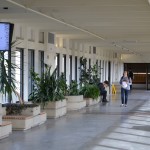It’s a dirty job, but someone has to do it. Cleaning up a winter’s worth of sand from the University of Lethbridge campus can be an onerous task, but it’s just part of a regular routine for the Grounds department.
About 100 yards of sand was spread across campus this past winter in order to keep campus walkways as safe as possible for pedestrians. Some weather events where crews were unable to clear the snow before it compacted or turned to ice, resulted in generous applications of sand, salt or ice melt products, leaving plenty of sand behind when the snow melted.
Workers try to save as much sand as possible to reuse the following year which helps the department save on costs to replenish its supply. However, the sand must be fairly clean – yes, clean dirt – otherwise it leads to dust, tracking or spreading of litter.
In order to get the sand in good, reusable condition, Grounds crews will first sweep the streets where the sand is cleanest. The sand is piled and stored at the bone yard until the weather warms up enough for it to be spread out and dried. After the sand is dry, workers hand pick out the litter, leaves and other debris, and the sand is piled back into the sand shed for use the following year.
Sand that has been piled onto grassy areas along roads and walkways is not suitable for reuse as it is usually mixed with a lot of litter and grass. However, some of this sand can be used for back fill or it can be spread on campus dirt trails to minimize mud. This sand is swept up with smaller sweepers so it can be picked up by a bigger sweeper afterwards. This helps avoid build up over time and reduces the risk of sand clogging up irrigation heads and destroying healthy grass.
Caretaking Manger Judy Jaeger says she appreciates the effort by Grounds crews as it means less work for her staff to clean up the sand that gets tracked into campus buildings.
“They do an awesome job,” she says. “Cleaning up the sand inside building entrances takes away from other work we do to keep classrooms and public spaces clean and tidy, so my employees are especially glad to see the sand cleared away outside.”
For more information on Grounds or its operations call 329-2602 or email facility.servicedesk@uleth.ca.
Visit the Facilities website.

 The Caretaking department has been busy refurbishing floors across the University of Lethbridge.
The Caretaking department has been busy refurbishing floors across the University of Lethbridge.